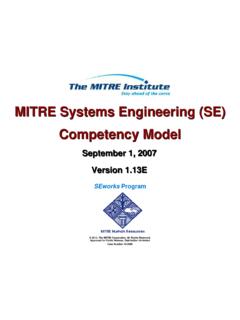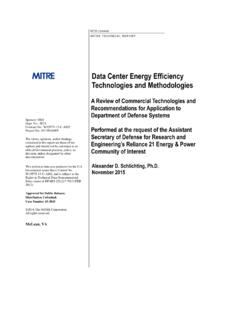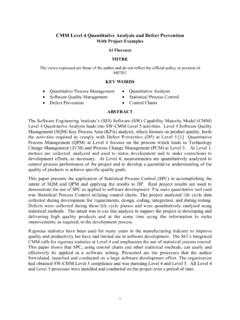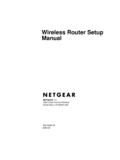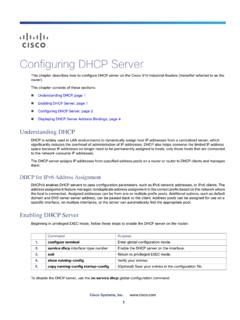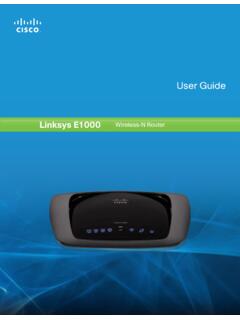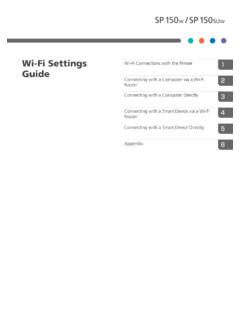Transcription of Cursor-on-Target Message Router User's Guide
1 Approved for Public Release; Distribution Unlimited Case # 09-4937. M P0 9 02 8 4. MIT R E P RO DU CT. Cursor-on-Target Message Router User's Guide November 2009. Michael J. Kristan Jeffrey T. Hamalainen Douglas P. Robbins Patrick J. Newell Sponsor: ESC Contract No.: FA8721-10-C-0001. Dept. No.: E146 Project No.: 031A3MA0-CT. The views, opinions and/or findings contained in this report are those of Approved for public release, distribution unlimited. The MITRE Corporation and should not be construed as an official Government position, policy, or decision, unless designated by other documentation. 2009 The MITRE Corporation.
2 All Rights Reserved. 202 Burlington Road Bedford, Massachusetts 01730. i table of Contents Page 1 Document Goal 1-1. 2 Cursor-on-Target Information 2-1. CoT Base Schema 2-1. Cot Sub-Schema 2-3. CoT Type Field Details 2-4. 3 Regular Expressions 3-1. 4 Additional Information 4-1. 5 Cursor-on-Targer Message Router Overview 5-1. 6 General Operation 6-1. Graphical User Interface 6-1. PubSub (1) 6-2. Active Subscription Buttons (2) 6-2. Active Subscription Window (3) 6-3. Log Window (5) 6-4. Editing Channels 6-4. Editing Events 6-6. Editing Tests 6-8. Editing Mods 6-10. Managing Subscriptions and Caches 6-12.
3 7 Subscription Examples 7-1. Blue Force Tracking 7-1. RainDrop and ADOCS 7-2. Appendix A A-1. ii List of Figur es Page Figure 2-1. Basic CoT XML Message .. 2-1. Figure 6-1. Message Router Graphical User Interface .. 6-1. Figure 6-2. PubSub Data Window .. 6-2. Figure 6-3. Channels Window .. 6-74. Figure 6-4. Channel Manager 6-76. Figure 6-5. Event Parameters Window .. 6-7. Figure 6-6. Edit Test Window .. 6-9. Figure 6-7. Edit Mods Window .. 6-11. Figure 6-8. Load 6-12. Figure 6-9. Debug Window .. 6-13. Figure 7-1. Example 1 Tests .. 7-1. Figure 7-2. Example 2 Tests Before 7-3. Figure 8-1. Subscription XML Error!
4 Bookmark not defined. iii List of Tables Page table 2-1. Required CoT Fields .. 2-2. table 3-1. Regular Expressions .. 3-2. table 6-1. Active Subscription Buttons and Functions .. 6-3. table 6-2. Event Parameters 6-8. table 6-3. Edit Test Tests .. 6-9. table 6-4. Edit Mods Edits .. 6-11. table 8-1. CoT Subscription Event Schema .. Error! Bookmark not defined. v 1 Document Goal This document describes functionality of the MITRE developed, proof of concept Message Router named the Cursor-on-Target Message Router . The goal is to provide sufficient detail to understand its intended use and to facilitate a general development of a test strategy for Cursor-on-Target (CoT).
5 The discussion in this document assumes some familiarity with the CoT concepts, schema, and sub-schema. The next sections include background information on CoT and Regular Expressions for reference purposes. More information about CoT can be found at The remainder of the document demonstrates configuration of CoT Message subscriptions, examples, and some more advanced uses. 1-1. 2 Cursor-on-Target Information The Cursor-on-Target (CoT) data strategy centers on the use of a common language for tactical systems that is critical in communicating much needed time sensitive position information. Analogous to functioning acceptably in foreign countries, while only learning a few important words of the native language, CoT starts with a focus on a particular set of important common information on the battlefield.
6 This is seen as a time sensitive position or the What, When, and Where (W3) of a specific event. The proof of concept prototype also allows for structured special purpose extensions. CoT Base Schema The CoT base schema defined in , is registered in the DISA DoD XML. registry and available at the website It defines a terse schema for representing W3 information, with a total of 12 mandatory fields as outlined in Figure 2-1 below, with a compliant example Message in table 2-1. The CoT base schema is terse by design, but also defines a mechanism for extension. The contents of CoT base schema were selected after studying a large number of DoD systems and realizing that many of the information exchange needs between these systems had a common core set, W3.
7 <?xml <?xml version=' '. version=' ' standalone='yes'?>. standalone='yes'?>. <event <event version=" ". version=" ". uid="J-01334". uid="J-01334". type="a-h-A-M-F-U-M". type="a-h-A-M-F-U-M". time="2005-04-05T11:43 ". time="2005-04-05T11:43 ". start="2005-04-05T11:43 ". start="2005-04-05T11:43 ". stale="2005-04-05T11:45 ". stale="2005-04-05T11:45 " >>. <detail>. <detail>. </detail>. </detail>. <point <point lat=" ". lat=" " lon=" ". lon=" " ce=" ". ce=" ". hae=" " le=" ". hae=" " le=" " />/>. </event>. </event>. Figure 2-1. Basic CoT XML Message 2-1. table 2-1. Required CoT Fields Opt/. Element Attribute Definition XML Schema Type Req Schema version of this event version Req Decimal equal to instance ( ).
8 Hierarchically organized hint string of pattern type Req about event type "\w+(-\w+)*(;[^;]*)?". Globally unique name for this uid Req string information on this event time stamp: when the event was time Req dateTime generated starting time when an event Event start Req dateTime should be considered valid ending time when an event stale Req should no longer be considered dateTime valid Gives a hint about how the how Req string of pattern \w-\w . coordinates were generated opex Opt qos Opt access Opt Latitude referred to the WGS 84. lat Req decimal -90 to 90 inclusive ellipsoid in degrees Longitude referred to the WGS decimal -180 to 180.
9 Lon Req 84 in degrees inclusive Height above the WGS ellipsoid hae Req decimal Point in meters Circular 1-sigma or a circular ce Req decimal area about the point in meters Linear 1-sigma error or an le Req altitude range about the point in decimal meters An optional element used to hold Detail N/A Opt empty element CoT sub-schema. 2-2. Cot Sub-Schema The CoT approach allows for definition of sub-schema based on common information exchange needs between systems that extend beyond the information provided by the basic W3 schema. One or more sub-schema may appear in the detail element in the base schema. This approach provides additional information exchange capability to the various systems that need to exchange more than the common schema allows.
10 For example, community applications that need W3 data exchanges to meet mission requirements may also need to know about the velocity of an event as well. If the velocity information was added to extend the base schema, CoT would have to define no statement values for these fields when they are not used, or make them optional. This will add complexity to software development projects that use the common W3 schema. CoT sub-schemas provide a means to extend CoT without the need for special-case processing. Other advantages to this approach include the encapsulation of data definition in small, manageable standards.

